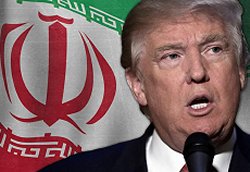
|
- Iran: Eight Prisoners Hanged on Drug Charges
- Daughter of late Iranian president jailed for ‘spreading lies’ - IRAN: Annual report on the death penalty 2016 - Taheri Facing the Death Penalty Again - Dedicated team seeking return of missing agent in Iran - Iran Arrests 2, Seizes Bibles During Catholic Crackdown
- Trump to welcome Netanyahu as Palestinians fear U.S. shift
- Details of Iran nuclear deal still secret as US-Tehran relations unravel - Will Trump's Next Iran Sanctions Target China's Banks? - Don’t ‘tear up’ the Iran deal. Let it fail on its own. - Iran Has Changed, But For The Worse - Iran nuclear deal ‘on life support,’ Priebus says
- Female Activist Criticizes Rouhani’s Failure to Protect Citizens
- Iran’s 1st female bodybuilder tells her story - Iranian lady becomes a Dollar Millionaire on Valentine’s Day - Two women arrested after being filmed riding motorbike in Iran - 43,000 Cases of Child Marriage in Iran - Woman Investigating Clinton Foundation Child Trafficking KILLED!
- Senior Senators, ex-US officials urge firm policy on Iran
- In backing Syria's Assad, Russia looks to outdo Iran - Six out of 10 People in France ‘Don’t Feel Safe Anywhere’ - The liberal narrative is in denial about Iran - Netanyahu urges Putin to block Iranian power corridor - Iran Poses ‘Greatest Long Term Threat’ To Mid-East Security |
Monday 14 February 2011Revolution. There’s an app for that.
Macleans.ca, A documentary on the Iranian uprising mixes cellphone video with animated blogs... In the early days of the Egyptian uprising, the most common fear dampening the jubilation in the streets of Cairo was that the revolt could meet the same ugly fate as the Iranian uprising of 2009. Now, with uncanny timing, a new documentary chronicles in vivid and harrowing detail just how Iran’s liberation movement was crushed in the wake of a fraudulent presidential election. The Green Wave, which opens Toronto’s Human Rights Watch Film Festival (Feb. 22 to March 4), is a new breed of documentary, one that is a product of what it portrays—a wave of digital democracy that has allowed protest to go viral in Iran, Tunisia and Egypt. Directed by Iranian expatriate Ali Samadi Ahadi, the film is composed of myriad images from cameras and mobile phones in the thick of the action, intercut with an animated narrative in the style of a graphic novel, along with interviews of prominent Iranian exiles. In Iran, severely restricted access prevented the world media from delivering the kind of on-the-ground reportage we’ve seen from Egypt. So the filmmakers created a pair of fictional student protesters—composite characters drawn from hundreds of blog entries—and dramatized their stories with animation. As a genre, the animated documentary was pioneered by two previous films about conflict in the Middle East, Persepolis (2007) and Waltz With Bashir (2008). Another innovative doc, Burma VJ, used a collage of clandestine amateur videos to chronicle Burma’s 2007 protests and the vicious crackdown that followed. Now, with its hybrid of vibrant graphics and ultra-vérité cellphone footage, The Green Wave combines those two techniques to produce yet another mutation of the ever-expanding documentary form. The crude video and rich animation make a potent combo. There’s a ghostly abstraction to the cellphone footage—which includes the now-iconic sight of 26-year-old Iranian Neda Agha-Soltan being gunned down in the street. The erratic, pixilated images are so fragmented they seem barely real; it makes you wonder what other hell is happening outside the frame. The animated sequences flesh out the missing narrative as bold memoir, re-enacting blogged accounts of police terror, imprisonment, torture and execution. The Green Wave’s story begins with the initial euphoria of Iran’s June 2009 election, as the streets are jammed with supporters of presidential candidate Mir Hossein Mousavi. Vast crowds of overjoyed demonstrators trail green banners and scarves, the democratic heraldry of Iran’s Green Revolution. Then, hopes are dashed by election fraud, opposition candidates are placed under house arrest, foreign media are expelled, and defiant protesters fill the streets demanding, “Where is my vote?” As the crackdown descends, the images become more chaotic. Gunfire cracks from rooftops, bodies drop to the ground, police on motorcyles attack with truncheons. A demonstrator, his face in shadow, recalls the horror: “While we were running away, I heard a noise. I turned around and saw someone’s head explode.” Cut to a blurred video of a man’s head bleeding onto the pavement as we hear panicked shouts: “How shall we lift him?… Turn him on his side! The blood’s running into his throat!” Cut to a typed Twitter feed: “young protester killed with bullet through the head on Navab street. 10:32 AM… Fatemiyeh Hospital Tehran: 30-40 dead; 200 injured. 11:59 PM.” Cut to an animated scene of the hospital ward, where a woman describes how police stripped IDs from the dead, and threw the bodies onto a truck: “What can you say to the family of a 13-year-old boy who died in a hail of bullets and whose body disappeared?” Between the operatic graphics and the eyewitness words, a raw poetry emerges, as if nothing else could contain the epic emotions at stake. Revolution finds resilience in poetry, which even spills into the mainstream media. Take the lyrical cadence of Anderson Cooper in Cairo reading his “reporter’s notebook.” Poet Gil Scott-Heron once said, “the revolution will not be televised.” But it’s gone beyond that. The revolution is being blogged, tweeted, shot and streamed by those in the act of making it. |






